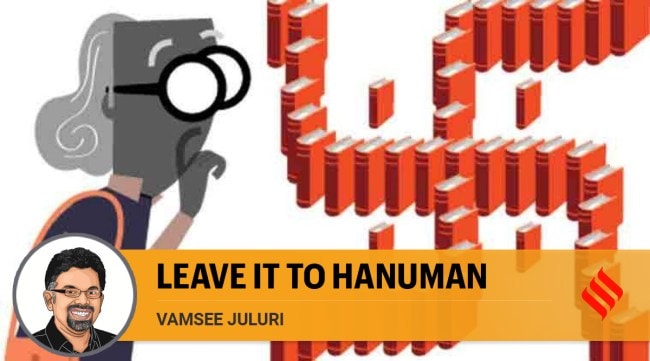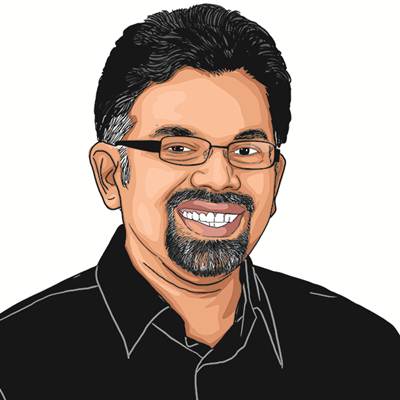Opinion Leave it to Hanuman
Vamsee Juluri writes: The problem isn’t communalism, but refusal to see another reality.
 For someone who has decided that the problem is Hinduism, no number of Hindu boys in hospitals, temples destroyed or prayer songs silenced will change their understanding.
For someone who has decided that the problem is Hinduism, no number of Hindu boys in hospitals, temples destroyed or prayer songs silenced will change their understanding.
It is ironic that Pratap Bhanu Mehta’s recent article is titled ‘With eyes wide open’ (IE, April 22). The real nature of the abyss may be obvious to everyone else, but what he presents is the view of a small class of people who have made it their sole virtue to keep their eyes firmly shut.
This descent into the abyss did not begin with Ram Navami or Hanuman Jayanti. Nor with some attack on the idea of India a few years ago.
The fall that Mehta tries to pin on Hanuman and Ram is an old, colossal and, worst of all, unnatural one.
The Hindu revivalist writer Ram Swarup’s phrase — one god, two humanities or many gods, one humanity — describes the dilemma succinctly. Two thousand years of monotheistic cultural imperialism have left only India and a few other nations with their old gods still standing. That is the big picture. Not “democratic backsliding”. Or even “clash of civilisations”.
One might say it’s in the past. But is it?
When I search for “Ram Navami” or “Hanuman Jayanti”, I see a spate of images that seem to have escaped Mehta’s sight altogether. I see a 16-year-old boy named Shivam Shukla with his head smashed in by a rock, struggling to breathe through a tube in a hospital bed. I see a woman crying for her home which has been set on fire. I see news of Hindu processions being attacked in Karnataka, Madhya Pradesh, Gujarat, West Bengal and New Delhi.
I see unnecessary pain and suffering. And lies.
I do not see a “new Hinduism” as Mehta says. Instead, I see a world where the divergence between reality and truth is so deep that no one cares to reach across the epistemic or digital divide any more.
For someone who has decided that the problem is Hinduism, no number of Hindu boys in hospitals, temples destroyed or prayer songs silenced will change their understanding.
For someone who has decided the problem is Islam, no amount of condemnation of Hinduism or charges of communalism will change their assumption either.
We have two parallel reality industries now — an older one which works in the denial of Hindu pain, and a newer one which prospers in the selective stoking of it for political gains. If we pretend only one matters — or worse, that the other doesn’t exist — we are no better than those we critique.
I do not see the need for Hindu youth to celebrate outside mosques with flags and swords. Yet, I cannot say they are the only ones doing it when video clips appear of Muslim youth apparently having done the same.
Tit-for-tat turf battles? A warped form of the American “Take Back the Night” sort of civic campaign? What is this public negotiation really about? And what happened to the spirit of Ishwar-Allah (or Ram-Rahim, as we used to sing in Prasanthi Nilayam)?
But I see a different trajectory than Mehta does, perhaps. For him, that spirit is gone, shredded by “communalism”, which is synonymous for him not with “Hindu Nationalism” or “Hindutva”, but just “Hinduism”. That fig leaf of a distinction is now gone.
This unintentionally honest admission reveals much about how “communalism” is understood in India. As Sufiya Pathan, a researcher with Ahmedabad-based Centre for Indic Studies, has written, the term began to be used about India only in the 1920s. It presented itself not as a European idea, but as an innate condition of India — of religion in India, to be precise. And not just any religion, but the religion that happens to be that of the “majority”, naturally, which has the burden of demonstrating “tolerance” at all costs.
And how exactly is Hinduism to do that? “The West,” writes Pathan, “did not see religious reform or the eradication of religion as a solution to its own inter-religious strife,” but saw reform as a return to a purer form of the church, always. But in India, “reform” meant the opposite, and it still does.
It means Hindu eradication. Destroy the “idols”. Raze the temples. Silence the festivals. Reduce Rama and Krishna to guilt-professing memes. An elephant is abused somewhere? Just make a weeping Ganesha meme refusing puja from his worshippers, as if they were the ones who abused it. A woman is assaulted? Blame the inadequacy of goddess-worship in preventing it, as if lands that destroyed their own age-old goddess images have somehow smashed patriarchy.
And where the misappropriation of images of the gods doesn’t suffice, simply make up new stories about them that no devout Hindu has before, and then demand, on the basis of these new legends, a ban on this or that “Aryan invader” festival.
Mehta and others see only the 75-year-long history of a secular republic being broken down. Others see the 2,000-year-long history of survival against the odds.
For Hindus who keep their eyes open, every day now is like The Darkening Age, Catherine Nixey’s study of the destruction of the indigenous traditions, temples and libraries of the old “pagan” world by Christianity. The only change is that in the old days it was in the name of one god, and now it’s in the name of progress or development.
And yet, for Hindus who follow Hanuman and Rama there remains a sense of hope. Politicians and ideologues may make spectacles or targets of Hanuman. But in the end, Hanuman is still what every Hindu wants to be in relation to the feet of Sita and Rama, not to some passing political episode.
Just say, “Jai Hanuman”, Mr Mehta, and leave it to him. You can’t surely believe in his beautiful and elegant spirit from the Sundara Kanda, and also believe he’s just a hateful trope now, can you?
The writer is professor of media studies at the University of San Francisco







